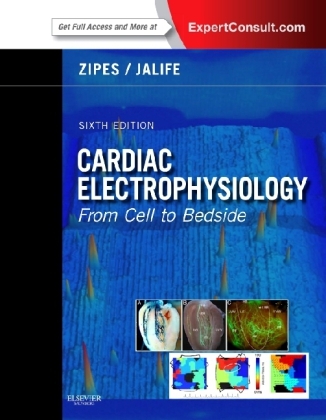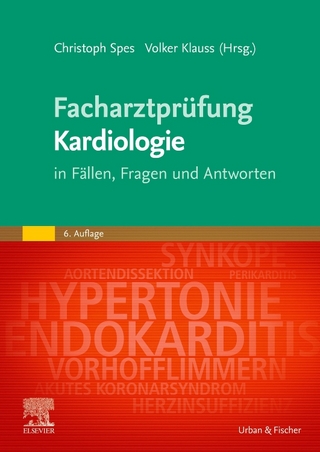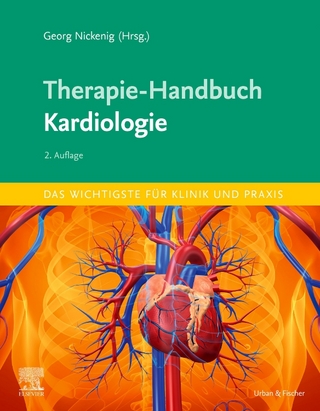
Cardiac Electrophysiology: From Cell to Bedside
Saunders (Verlag)
978-1-4557-2856-5 (ISBN)
- Titel erscheint in neuer Auflage
- Artikel merken
Cardiac Electrophysiology: From Cell to Bedside puts the latest knowledge in this subspecialty at your fingertips, giving you a well-rounded, expert grasp of every cardiac electrophysiology issue that affects your patient management. Drs. Zipes, Jalife, and a host of other world leaders in cardiac electrophysiology use a comprehensive, multidisciplinary approach to guide you through all of the most recent cardiac drugs, techniques, and technologies.
KEY FEATURES:
- Get well-rounded, expert views of every cardiac electrophysiology issue that affects your patient management from preeminent authorities in cardiology, physiology, pharmacology, pediatrics, biophysics, pathology, cardiothoracic surgery, and biomedical engineering from around the world.
- Visually grasp and easily absorb complex concepts through an attractive full-color design featuring color photos, tables, flow charts, ECGs, and more!
NEW:
- Integrate the latest scientific understanding of arrhythmias with the newest clinical applications, to select the right treatment and management options for each patient.
- Stay current on the latest advancements and developments with sweeping updates and 52 NEW chapters - written by many new authors - on some of the hottest cardiology topics, such as new technologies for the study of the molecular structure of ion channels, molecular genetics, and the development of new imaging, mapping and ablation techniques.
- Get expert advice from Dr. Douglas P. Zipes - a leading authority in electrophysiology and editor of Braunwald’s Heart Disease and the Heart Rhythm Journal - and Dr. Jose Jalife - a world-renowned leader and researcher in basic and translational cardiac electrophysiology.
- Access the full text online at Expert Consult, including supplemental text, figures, tables, and video clips.
Douglas P. Zipes, MD, Distinguished Professor, Professor Emeritus of Medicine, Pharmacology, and Toxicology, Director Emeritus, Division of Cardiology and the Krannert Institute of Cardiology, Indiana University School of Medicine, Indianapolis, IN
Jose Jalife, MD, Cyrus and Jane Farrehi Professor of Cardiovascular Research Professor of Internal Medicine Professor of Molecular and Integrative Physiology University of Michigan Medical School Co-Director, University of Michigan Center for Arrhythmia Research Ann Arbor, Michigan
Part I. Structural and Molecular Bases of Ion Channel Function
1 Voltage-Gated Sodium Channels and Electrical Excitablility of the Heart
2 Calcium Channels in the Heart
3 Voltage-Regulated Potassium Channels
4 Structural and Molecular Bases of Inward Rectifier Potassium Channel Function
5 Mammalian Calcium Pumps in Health and Disease
6 Structural and Molecular Bases of Sarcoplasmic Reticulum Ion Channel Function
7 Structural and Molecular Bases of Mitochondrial Ion Channel Function
8 Molecular Organization, Gating, and Function of Gap Junction Channels
Part II. Biophysics of Cardiac Ion Channel Function
9 Biophysics of Normal and Abnormal Cardiac Sodium Channel Function
10 Regulation of Cardiac Calcium Channels
11 KCNQ1/KCNE1 Macromolecular Signaling Complex: Channel Microdomains and Human Disease
12 Structural Determinants and biophysical properties of hERG channel gating
13 Molecular regulation of cardiac inward rectifier potassium channels by harmacologic agents
14 Cardiac Stretch-Activated Channels and Mechano-Electric Coupling
15 Biophysical Properties of Gap Junctions
16 Excitation-Contraction Coupling
Part III. Intermolecular Interactions and Cardiomyocyte Electrical Function
17 Ion Channel Trafficking in the Heart
18 Macromolecular Complexes and Regulation of the Sodium Channel Nav1.5
19 Calmodulin and CaMKII as Ca2+ switches for cardiac ion channels
20 Macromolecular Complexes and Cardiac Potassium Channels
21 Reciprocity of Cardiac Sodium and Potassium channels in the control of Excitability and Arrhythmias
22 The Intercalated Disc: A Molecular Network that Integrates Electrical Coupling, Intercellular Adhesion, and Cell Excitability
23 Scaffolding Proteins and Ion Channel Diseases
24 Epigenetics in Cardiac Rhythm Diseases
Part IV. Cell Biology of Cardiac Impulse Initiation and Propagation
25 Cardiac Impulse is Initiated by a Coupled System of Membrane Ion Channels and Ca2+ Cycling Proteins
26 Biological Pacing
27 Intercellular Communication and Impulse Propagation
28 Mechanisms of Atrioventricular Nodal Excitability and Propagation
29 Cell Biology of the Specialized Cardiac Conduction System
30 Cardiac Fibroblasts and Arrhythmogenesis
Part V. Models of Cardiac Excitation
31 Ionic Mechanisms of Atrial Action Potentials
32 Models of the Ventricular Action Potential in Health and Disease
33 Calcium Signaling in a Cardiomyocyte Models with Realistic Geometries
34 Theory of Rotors and Arrhythmias
35 Supraventricular Arrhythmias in a Realistic 3D model of the Human Atria
36 Cardiac Electromechanical Models
Part VI. Neural Control of Cardiac Electrical Activity
37 Cav1.2 and ß-Adrenergic regulation of cardiac function
38 cholinergic and constitutive regulation of atrial potassium channel
39 Pulomnary vein ganglia and the neural regulation of the heart rate
40 Neural activity and atrial tachyarrhythmias
41 Sympathetic Innervation, Denervation, and cardiac arrhythmias
Part VII. Arrhythmia Mechanisms
42 Dominant Frequency and the Mechanisms of Initiation and Maintenance of Atrial Fibrillation
43 Rotors in Human Atrial Fibrillation
44 atrial ischemia and fibrillation
45 The Molecular pathophysiology of atrial fibrillation
46 Myofibroblasts, Cytokines and Persistent Atrial Fibrillation
47 Role of The Autonomic Nervous System In Atrial Fibrillation
48 Mechanisms of ventricular tachycardia and fibrillation
Part VIII. Molecular Genetics and Pharmacogenomics
49 Genetics of Atrial Fibrillation
50 Mechanisms in Heritable Sodium Channel Diseases
51 Inheritable Potassium Channel Disease
52 Genetics and Cellular Mechanisms of the J Wave Syndromes
53 Inheritable Phenotypes Associated with Altered Intracellular Calcium Regulation
Part IX. Pharmacologic, Genetic and Cell Therapy of Ion Channel Dysfunction
54 Pharmacologic Bases of Antiarrhythmic Therapy
55 Pharmacogenomics of Cardiac Arrhythmias
56 Optogenetic Control of Heart Muscle
57 Cell Therapy and Regeneartive Electrophysiology
Part X. Diagnostic Evaluation
58 Assessment of the Patient with a Cardiac Arrhythmia
59 Differential Diagnosis of Narrow and Wide Complex Tachycardias
60 Mapping and Navigation
61 CT and MR Imaging for Electrophysiology
62 Intracardiac Echocardiography for Electrophysiology
63 Exercise -Induced Arrhythmias
64 Cardiac Monitoring: Short- and Long-Term Recording
65 Electrocardiographic Imaging in Patients with Acute Coronary Syndrome
66 Head-up Tilt Table Testing
67 Autonomic Testing and Cardiac Risk
68 Monophasic Action Potential Recording
69 T-Wave Alternans
70 Noninvasive Electrocardiographic Imaging of Human Ventricular Arrhythmias and Electrophysiologic Substrate
71 Genetic Testing
Part XI. Supraventricular Tachyarrhythmias: Mechanisms, Clinical Features, and Management
72 Sinus Node Abnormalities
73 Atrial Tachycardia
74 Typical and Atypical Atrial Flutter: Mapping and Ablation
75 Atrial Fibrillation: Paroxysmal, Persistent, and Permanent
76 Preexcitation, Atrioventricular Reentry, and Variants
77 Electrophysiological Characteristics of Atrioventricular Nodal Reentrant Tachycardia: Implications for the Reentrant Circuits
78 Atrial Arrhythmias in Adults With Congenital Heart Disease
79 Junctional Tachycardia
Part XII. Ventricular Tacharrhythmias: Mechanisms, Clinical Features, and Management
80 Premature Ventricular Complexes
81 Outflow Tract Ventricular Tachyarrhythmias: Mechanisms, Clinical Features, and Management
82 Fascicular Ventricular Arrhythmias
83 Bundle Branch Reentry Tachycardia
84 Ischemic Heart Disease
85 Ventricular Tachycardia in Patients with Dilated Cardiomyopathy
86 Ventricular Arrhythmias in Hypertrophic Cardiomyopathy
87 Ventricular Tachycardias in Arrhythmogenic Right Ventricular Dysplasia/Cardiomyopathy
88 VTs in Catecholaminergic Cardiomyopathy (Catecholaminergic Polymorphic Ventricular Tachycardia)
89 Ventricular Arrhythmias in Heart Failure
90 Ventricular Tachycardia in Noncompaction Cardiomyopathy
91 Ventricular Arrhythmias in Takatsubo Cardiomyopathy
92 Brugada Syndrome 1992-2012: Twenty Years of Scientific Progress
93 Long and Short QT Syndromes
94 Andersen-Tawil Syndrome
95 Timothy Syndrome
96 J Wave Syndromes
97 Idiopathic Ventricular Fibrillation
98 Sudden Infant Death Syndrome
99 Sudden Cardiac Death in Adults
100 Arrhythmias in Patients with Neurologic Disorders
101 Drug-Induced Ventricular Tachycardia
102 Ventricular Arrhythmias in Congenital Heart Disease
Part XIII. Syncope and AV Block
103 Syncope
104 Postural Orthostatic Tachycardia Syndrome
105 Progressive Conduction System Disease
106 Atrioventricular Block
Part XIV. Arrhythmias in Special Populations
107 Sex Differences in Arrhythmias
108 Sudden Cardiac Deaths in Athletes, Including Commotio Cordis
109 Arrhythmias in Pediatric Population
110 Sleep-Disordered Breathing and Arrhythmias
Part XV. Pharmocologic Therapy
111 Standard Antiarrhythmic Drugs
112 New Antiarrhythmic Drugs and New Concepts for Old Drugs
113 Impact of Nontraditional Antiarrhythmic Drugs on Sudden Cardiac Death
114 Prevention of Stroke with Atrial Fibrillaiton
Part XVI. Electrical Therapy
115 Implantable Cardioverter Defibrillators: Technical Aspects
116 Implantable Cardioverter Defibrillators: Clinical Aspects
117 Implantable Pacemakers
118 Cardiac Resynchronization Therapy
119 Newer Applications of Pacemakers
120 Catheter Ablation: Technical Aspects
121 Catheter Ablation: Clinical Aspects
122 Ablation for Atrial Fibrillation
123 Ablation of Supraventricular Tachyarrhythmias
124 Catheter Ablation for Ventricular Tachycardia in Patients with Structural Heart Disease
125 Special Ablation Approaches: Epicardial, Other
126 Ablation in Pediatrics
127 Catheter Ablation in Congenital Heart Disease
Part XVII. Surgery for Arrhythmias
128 Atrial Fibrillation and Other SVTs
129 Surgery for Ventricular Arrhythmias
Part XVIII. New Approaches
130 Vagal Stimulation for Heart Failure
131 Spinal Cord Stimulation for Heart Failure and Arrhythmias
132 Left Atrial Occluders/Isolation
| Zusatzinfo | Approx. 700 illustrations (550 in full color) |
|---|---|
| Verlagsort | München |
| Sprache | englisch |
| Maße | 222 x 281 mm |
| Gewicht | 2994 g |
| Einbandart | gebunden |
| Themenwelt | Medizinische Fachgebiete ► Innere Medizin ► Kardiologie / Angiologie |
| ISBN-10 | 1-4557-2856-X / 145572856X |
| ISBN-13 | 978-1-4557-2856-5 / 9781455728565 |
| Zustand | Neuware |
| Haben Sie eine Frage zum Produkt? |
aus dem Bereich



